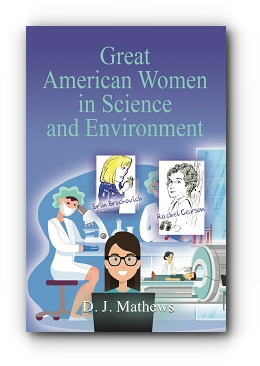| ||||||||||||||||
| Category: Biography |
(requires Adobe Reader)
|
| About the Book | |
|
Why does anyone develop an interest in science? Why should anyone care about saving the environment? Curiosity is part of it. Curiosity, with some support and inspiration. In "Great American Women in Science and Environment," we meet some very curious women who early in life have a great interest in science and nature. Elizabeth Blackwell, the third of eight children, was needed for caretaking, but it was a sick woman who encouraged her to study to be our first woman doctor.She was accepted into Geneva College because the all male students voted yes and thought it was all a joke. But she showed up and surprised them all! Later, she would have to open her OWN hospital for women and children in order to be taken seriously. Rachel Carson's mother taught her to welcome the nature outside their door -- later she would become the family's sole breadwinner and made a living writing for the U.S. Fish and Wildlife Service (its present name) before a friend suggested she write about the dangers of DDT. Some women "fell" into their calling, such as Erin Brockovich. She was a divorced mother of three. She had been a party girl in high school and college, but she had the learning disability of dyslexia to contend with. After a car accident required a lawyer's help, she decided to work for lawyer Ed Masry and learn more about all the sick people living in the town of Hinkley, California. Her huge lawsuit against the polluter, PG&E, made her a big celebrity when a movie was made about her life. Julia "Butterfly" Hill had not planned to spend over a year of her life in a tall redwood to protect it, but some things are just too important to ignore. And Madam C. J. Walker "had" to find a way to cure her growing baldness and get out of washing clothes in big tubs all day, which was tiring. So she became her own chemist and -- Presto -- came up with haircare products to help other African American women have products geared toward their own hair. She also helped create a sales force of black women for her products, probably her even bigger contribution to American society in the early 1900s. But there was friction in her marriage and she carried on without him. There are several others in the book whose stories of endurance, curiosity, and brave firsts should inspire young and old alike to want to work for a better future. We will need ideas on creating new sources of energy, meeting cybersecurity needs -- Grace Hopper, the mother of modern computer programming, also has a chapter -- cures of various diseases, getting people to possibly go to the planet Mars in the future. The possibilities are out there, as these young women show. Erin Brockovich spoke at Catawba College in North Carolina in 2016. One poignant thing she said was that you sometimes have to depend on yourself to make a difference in this world, like the women in "Great American Women." She said, "Sometimes, you have to be your own hero." Gertude Elion, a researcher, took this advice to heart, helping to create drugs to cure childhood leukemia, even though her supervisor George Hitchings was getting all the credit. (She finally received a Nobel Prize in 1988. Her team also created AZT, which helps AIDS virus victims survive.)
|
|
| Reviews | |
"'Great American Women in Science and Environment' was fun to read and I learned a lot." "This book offers young readers the opportunity to meet some real-life role models from the world of Science."
|
|
| Related Titles | |
|
|
| About the Author | |
 |
D. J. Mathews is a Master naturalist member who has written for many publications. These include GEICO DIRECT, Virginia Wildlife, Virginia Journal of Education, The Bristol Herald Courier (VA) and website articles for Blue Ridge Country and the Roanoke Times. She is currently working on a novel about public education. |

